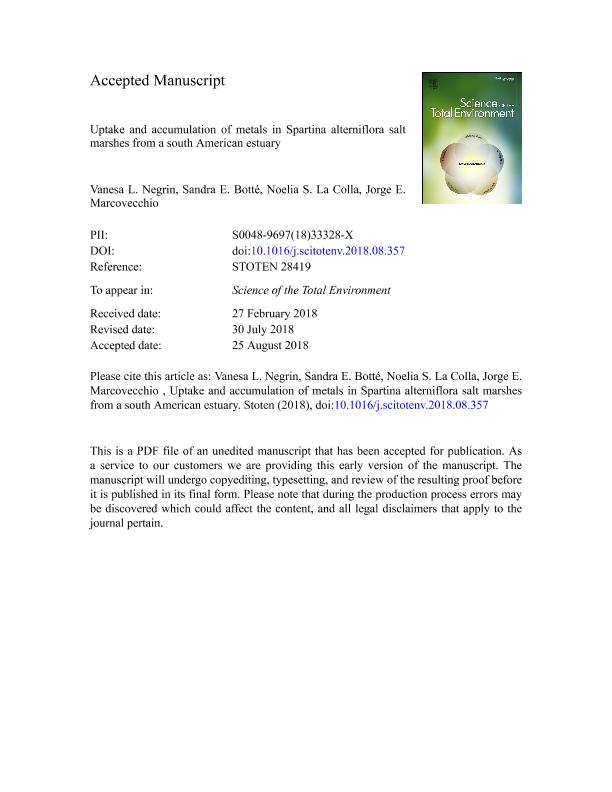Artículo
Uptake and accumulation of metals in Spartina alterniflora salt marshes from a South American estuary
Negrin, Vanesa Lorena ; Botté, Sandra Elizabeth
; Botté, Sandra Elizabeth ; la Colla, Noelia Soledad
; la Colla, Noelia Soledad ; Marcovecchio, Jorge Eduardo
; Marcovecchio, Jorge Eduardo
 ; Botté, Sandra Elizabeth
; Botté, Sandra Elizabeth ; la Colla, Noelia Soledad
; la Colla, Noelia Soledad ; Marcovecchio, Jorge Eduardo
; Marcovecchio, Jorge Eduardo
Fecha de publicación:
02/2019
Editorial:
Elsevier Science
Revista:
Science of the Total Environment
ISSN:
0048-9697
Idioma:
Inglés
Tipo de recurso:
Artículo publicado
Clasificación temática:
Resumen
Salt marshes are capable of reducing metal pollution in coastal waters, but this capacity is highly dependent on the metal, the physico-chemical characteristics of the sediment, the plant species, the production of biomass, the time of the year, etc. The aim of this study was to assess the uptake and accumulation of Pb, Ni, Cu and Zn in Spartina alterniflora from three salt marshes within the Bahía Blanca estuary (BBE), a human-impacted Argentinean system. Metal concentrations in sediments and plants showed the same order at all sites: Zn > Cu > Pb ≥ Ni. The site with lower organic matter and fine sediment content had lower metal concentrations in the sediments, but not a lower metal content in the plant tissues, meaning that the sediment characteristics influenced the metal concentrations in the sediment and their uptake by plants. Despite differences in sediment characteristics between sites, metals were always higher in the belowground tissues than in aboveground ones and, in general, higher in dead than in live tissues. Some metals were accumulated in plant tissues, but not others, and this is dependent on the metal and the sediment characteristics. Allocation patterns of metals in tissues of S. alterniflora were mainly dependent on metal concentrations, determining higher belowground pools, but the aboveground pools were important in some cases due to higher biomass. Partitioning of metals in above or belowground pools determines their fate within the estuarine system, since tissues can decompose in situ (belowground) or be exported (aboveground). Seasonal dynamics were important for some variables but were less noticeable than the differences between sites and tissues. Our results indicate that S. alterniflora from the BBE is efficient in accumulating some metals, despite usually low metal concentrations in sediments and plants. This accumulation capacity has implications for the whole system through the fate of the tissues.
Palabras clave:
BAHÍA BLANCA
,
BIOCONCENTRATION
,
HALOPHYTES
,
SEDIMENTS
,
WETLANDS
Archivos asociados
Licencia
Identificadores
Colecciones
Articulos(IADO)
Articulos de INST.ARG.DE OCEANOGRAFIA (I)
Articulos de INST.ARG.DE OCEANOGRAFIA (I)
Citación
Negrin, Vanesa Lorena; Botté, Sandra Elizabeth; la Colla, Noelia Soledad; Marcovecchio, Jorge Eduardo; Uptake and accumulation of metals in Spartina alterniflora salt marshes from a South American estuary; Elsevier Science; Science of the Total Environment; 649; 2-2019; 808-820
Compartir
Altmétricas



